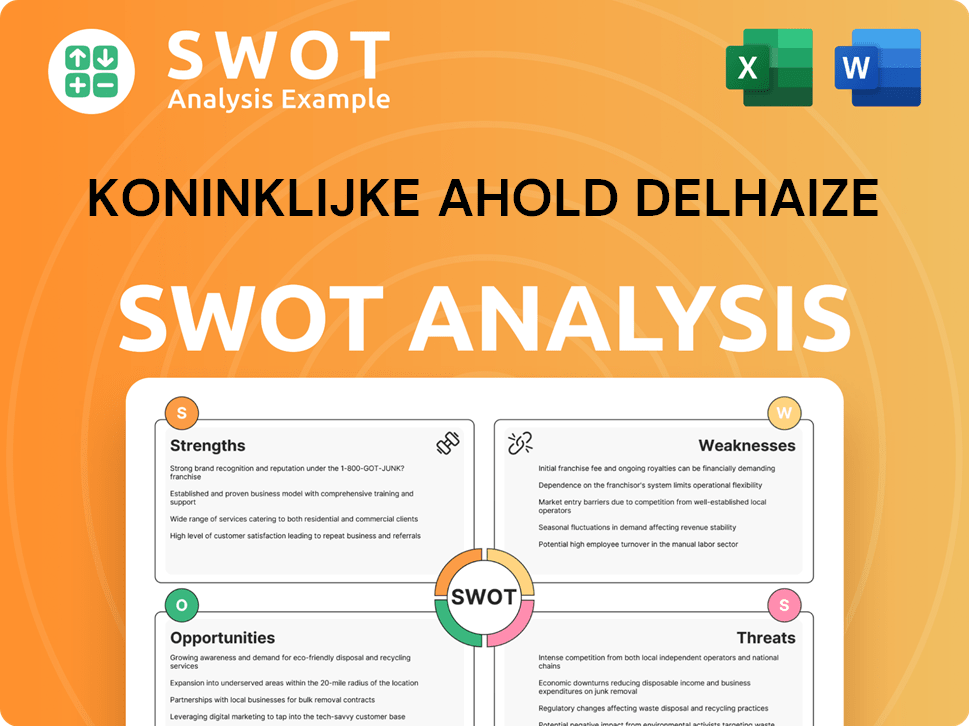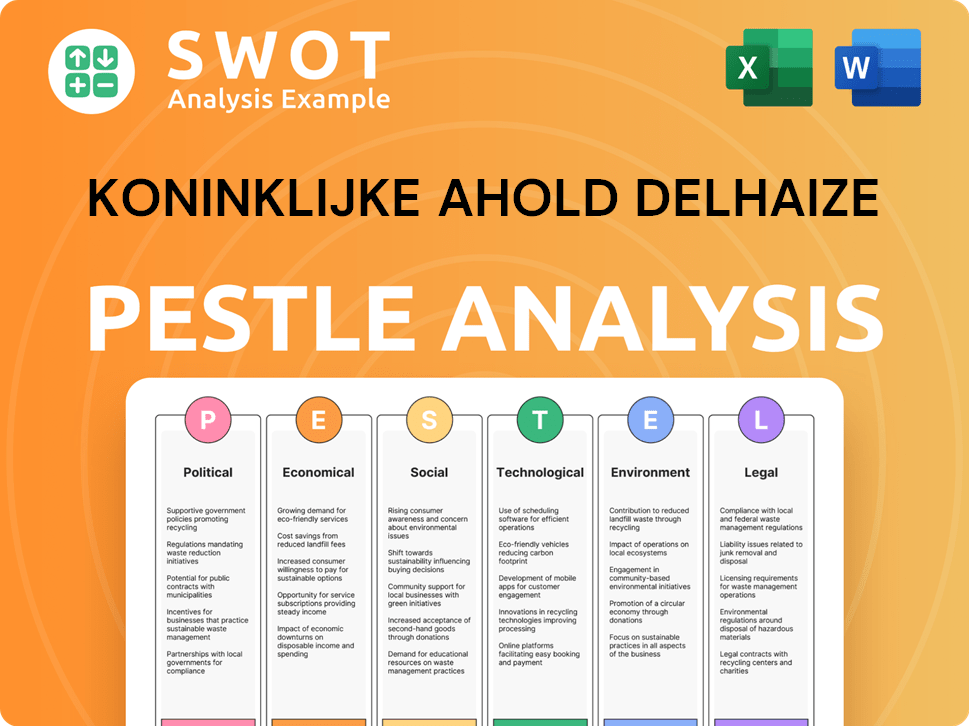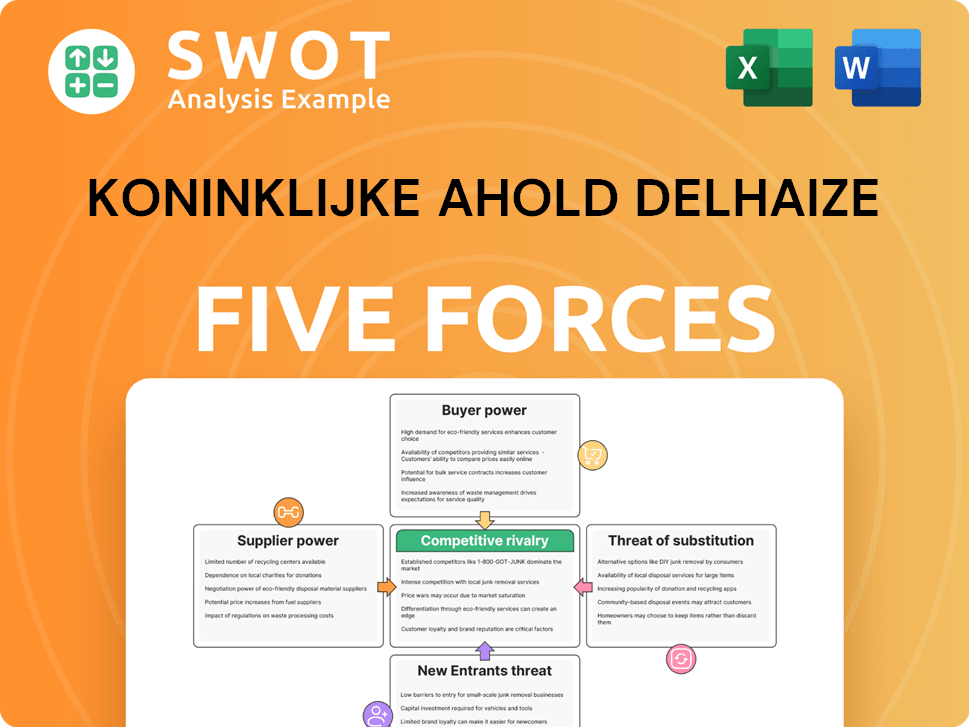Koninklijke Ahold Delhaize Bundle
How did a single Dutch grocery store become a global retail powerhouse?
Koninklijke Ahold Delhaize's story is a compelling narrative of growth, adaptation, and strategic innovation within the dynamic world of grocery retail. From its humble beginnings in 1887 as Albert Heijn, a local Dutch grocer, the company has transformed into a multinational giant. Understanding the Koninklijke Ahold Delhaize SWOT Analysis is crucial to understanding its trajectory.

This brief history of Ahold Delhaize explores its origins, key milestones, and the strategic decisions that shaped its evolution. The company's journey, marked by mergers and international expansion, offers valuable insights into the competitive landscape of the grocery retail sector. Discover how Ahold Delhaize, with its diverse brands and retail locations, has navigated challenges and capitalized on opportunities to become a leading force in the industry, and the company's financial performance.
What is the Koninklijke Ahold Delhaize Founding Story?
The Ahold Delhaize history is a story of growth and adaptation in the ever-changing world of grocery retail. The company's roots trace back to a single store, marking the beginning of a journey that would transform it into a global leader. Understanding the Ahold Delhaize origins provides valuable insights into its current operations and future strategies.
The direct lineage of Koninklijke Ahold Delhaize begins with the founding of Albert Heijn on May 27, 1887. This marked the start of what would become a major player in the grocery retail industry. The initial focus was on providing quality groceries to the local community.
Albert Heijn, a 21-year-old, took over his parents' grocery store in Oostzaan, Netherlands. He recognized the need for a reliable source of groceries for the growing local population. The business model was that of a traditional neighborhood grocer, offering a range of essential food items. One of the early innovations was Heijn's direct relationships with farmers and suppliers to ensure product quality. Initial funding came from the family business. The late 19th-century Netherlands, with its growing urban centers, provided a good environment for the grocery business.
The company started as a small grocery store and grew by focusing on quality and direct sourcing. This approach helped it to establish a strong customer base and build a reputation for reliability. The early success of the business set the stage for future expansion and innovation.
- Founded in 1887 by Albert Heijn.
- Focused on providing quality groceries to the local community.
- Emphasized direct sourcing from farmers and suppliers.
- Early funding came from the family business.
For more detailed information about the business approach, you can read about the Marketing Strategy of Koninklijke Ahold Delhaize.
Koninklijke Ahold Delhaize SWOT Analysis
- Complete SWOT Breakdown
- Fully Customizable
- Editable in Excel & Word
- Professional Formatting
- Investor-Ready Format

What Drove the Early Growth of Koninklijke Ahold Delhaize?
The early growth and expansion of the company, a precursor to Koninklijke Ahold Delhaize, began with a focus on the Netherlands. This period saw the establishment of more stores and the introduction of private-label products, crucial steps in building brand loyalty. Early milestones included reaching a significant number of stores and customers, solidifying its position as a prominent Dutch retailer. The company's strategic moves, such as adopting self-service formats, improved operational efficiency.
In the early 20th century, the company, which is part of the Ahold Delhaize history, expanded beyond Oostzaan, opening stores in nearby towns and cities. This growth was organic, fueled by reinvestment of profits and a focus on quality and efficiency. The company's expansion was well-received by consumers seeking convenience and a wider selection of goods.
Early product launches extended beyond basic groceries. The company started roasting its own coffee, showcasing an early vertical integration strategy. The introduction of its own private-label products was a significant step in building brand loyalty and controlling costs. This diversification helped the company to become a key player in grocery retail.
A pivotal moment in its early growth was the establishment of a central warehouse and distribution system, which allowed for more efficient supply chain management. Strategic shifts included the adoption of self-service formats in the mid-20th century, significantly improving operational efficiency and customer experience. These moves helped the company to gain market share.
The company’s growth efforts were well-received by the market, as consumers increasingly sought convenience and a wider selection of goods. The competitive landscape in the early 20th century was fragmented, allowing the company to gain market share through its focus on quality and efficiency. For more information on the company's values, see Mission, Vision & Core Values of Koninklijke Ahold Delhaize.
Koninklijke Ahold Delhaize PESTLE Analysis
- Covers All 6 PESTLE Categories
- No Research Needed – Save Hours of Work
- Built by Experts, Trusted by Consultants
- Instant Download, Ready to Use
- 100% Editable, Fully Customizable

What are the key Milestones in Koninklijke Ahold Delhaize history?
The history of Koninklijke Ahold Delhaize is marked by significant milestones that have shaped its growth and market position within the grocery retail industry. From its origins to its current global presence, the Ahold Delhaize company has undergone considerable transformation. The Ahold Delhaize history reflects strategic decisions and adaptations to changing market dynamics.
| Year | Milestone |
|---|---|
| 1887 | Albert Heijn opens his first grocery store in the Netherlands, marking the beginning of Ahold's journey. |
| 1972 | Ahold acquires Bi-Lo in the United States, representing a major step in its international expansion. |
| 2003 | Ahold faces financial difficulties due to accounting irregularities within its U.S. Foodservice division. |
| 2016 | The merger of Ahold and Delhaize Group creates Koninklijke Ahold Delhaize, forming a global food retail leader. |
| 2023 | Online sales reach over €10 billion, demonstrating a strong omnichannel strategy. |
Koninklijke Ahold Delhaize has consistently embraced innovation to enhance its market position. A key early innovation was the adoption of the self-service supermarket model by Albert Heijn, revolutionizing the shopping experience. The company has also focused on developing strong private label brands, providing value to customers and increasing profitability.
Albert Heijn's early adoption of the self-service supermarket model in the Netherlands set a new standard in the grocery retail industry.
Development and promotion of private label brands have consistently offered value to customers and improved profit margins.
Investing in an omnichannel strategy, including significant growth in online sales, has been a key focus.
Koninklijke Ahold Delhaize has expanded its sustainable product offerings and initiatives to meet changing consumer preferences.
Significant investments in e-commerce have been made to adapt to the evolving retail landscape, with online sales reaching over €10 billion in 2023.
The company has increased its focus on local product offerings to cater to regional consumer preferences and support local economies.
Ahold Delhaize has faced numerous challenges throughout its history, influencing its strategic direction. The accounting irregularities in the early 2000s led to a significant financial crisis and loss of investor confidence, necessitating restructuring. Competition from discounters and online retailers has consistently required adaptation and investment in e-commerce capabilities, as discussed in the growth strategy of Koninklijke Ahold Delhaize.
The early 2000s saw accounting irregularities that led to a major financial crisis and a loss of investor confidence.
Competition from discounters and online retailers has consistently challenged Ahold Delhaize's market position, requiring ongoing adaptation.
Navigating global economic downturns and shifts in consumer preferences towards healthier and more sustainable products required strategic repositioning.
Adapting to the rapid growth of e-commerce and online retail has required significant investment and strategic adjustments.
Responding to evolving consumer preferences for healthier and more sustainable products has been a constant focus.
Ahold Delhaize has had to navigate global economic downturns, requiring strategic agility and financial resilience.
Koninklijke Ahold Delhaize Business Model Canvas
- Complete 9-Block Business Model Canvas
- Effortlessly Communicate Your Business Strategy
- Investor-Ready BMC Format
- 100% Editable and Customizable
- Clear and Structured Layout

What is the Timeline of Key Events for Koninklijke Ahold Delhaize?
The Ahold Delhaize history is marked by significant milestones in the grocery retail industry. From its humble beginnings in the late 19th century to its current status as a global leader, the company has consistently adapted and expanded its operations. The
Koninklijke Ahold Delhaize
company's journey reflects a commitment to innovation, strategic acquisitions, and a focus on meeting evolving consumer needs.| Year | Key Event |
|---|---|
| 1887 | Albert Heijn opens his first grocery store in Oostzaan, Netherlands, marking the beginning of the company's story. |
| 1948 | Albert Heijn introduces the first self-service supermarket in the Netherlands, revolutionizing the grocery shopping experience. |
| 1973 | Albert Heijn N.V. goes public on the Amsterdam Stock Exchange, signaling a new phase of growth and expansion. |
| 1976 | The company is granted the 'Koninklijk' (Royal) designation, becoming Koninklijke Ahold N.V., a testament to its prominence. |
| 1977 | Ahold makes its first major acquisition in the United States, acquiring Bi-Lo, initiating its international expansion. |
| 1981 | Ahold acquires Giant Food Inc., further solidifying its presence in the U.S. market. |
| 1998 | Ahold acquires U.S. Foodservice, diversifying its business portfolio significantly. |
| 2003 | Ahold faces a major accounting scandal at U.S. Foodservice, leading to significant restructuring and changes. |
| 2016 | Ahold merges with Delhaize Group, forming Ahold Delhaize, creating a global grocery retail powerhouse. |
| 2020 | Ahold Delhaize sees significant growth in online sales due to the COVID-19 pandemic, accelerating its digital transformation. |
| 2023 | Ahold Delhaize reports net sales of €88.6 billion and online sales exceeding €10 billion, demonstrating strong financial performance. |
Koninklijke Ahold Delhaize is focused on strengthening its omnichannel presence. This involves integrating physical stores with e-commerce platforms. The goal is to provide seamless shopping experiences for customers.
The company is investing in digital transformation, supply chain optimization, and data analytics. This is to enhance efficiency and personalize customer offerings. They aim to use data to improve the customer experience and streamline operations.
Ahold Delhaize plans to leverage its strong positions in the U.S. and Europe while exploring emerging markets. Innovation includes developing private label brands and expanding sustainable product assortments. They are also adopting new retail technologies.
Industry trends, such as demand for convenience and health-conscious choices, are key for the company's future. Leadership emphasizes being a local omnichannel leader, focused on great food and value. Sustainable operations are also a priority.
Koninklijke Ahold Delhaize Porter's Five Forces Analysis
- Covers All 5 Competitive Forces in Detail
- Structured for Consultants, Students, and Founders
- 100% Editable in Microsoft Word & Excel
- Instant Digital Download – Use Immediately
- Compatible with Mac & PC – Fully Unlocked

Related Blogs
- What is Competitive Landscape of Koninklijke Ahold Delhaize Company?
- What is Growth Strategy and Future Prospects of Koninklijke Ahold Delhaize Company?
- How Does Koninklijke Ahold Delhaize Company Work?
- What is Sales and Marketing Strategy of Koninklijke Ahold Delhaize Company?
- What is Brief History of Koninklijke Ahold Delhaize Company?
- Who Owns Koninklijke Ahold Delhaize Company?
- What is Customer Demographics and Target Market of Koninklijke Ahold Delhaize Company?
Disclaimer
All information, articles, and product details provided on this website are for general informational and educational purposes only. We do not claim any ownership over, nor do we intend to infringe upon, any trademarks, copyrights, logos, brand names, or other intellectual property mentioned or depicted on this site. Such intellectual property remains the property of its respective owners, and any references here are made solely for identification or informational purposes, without implying any affiliation, endorsement, or partnership.
We make no representations or warranties, express or implied, regarding the accuracy, completeness, or suitability of any content or products presented. Nothing on this website should be construed as legal, tax, investment, financial, medical, or other professional advice. In addition, no part of this site—including articles or product references—constitutes a solicitation, recommendation, endorsement, advertisement, or offer to buy or sell any securities, franchises, or other financial instruments, particularly in jurisdictions where such activity would be unlawful.
All content is of a general nature and may not address the specific circumstances of any individual or entity. It is not a substitute for professional advice or services. Any actions you take based on the information provided here are strictly at your own risk. You accept full responsibility for any decisions or outcomes arising from your use of this website and agree to release us from any liability in connection with your use of, or reliance upon, the content or products found herein.